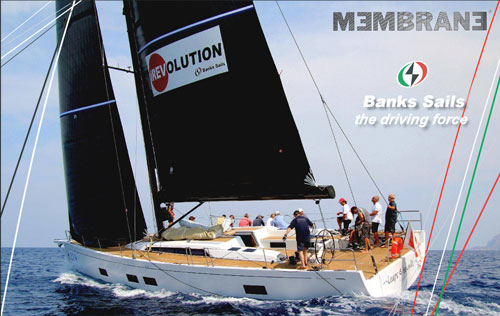MEMBRANE is not only a specific material made by our innovative and exclusive technologies but is a different approach to the building process of a sail with no dimensional limits: MEMBRANE is ART, SCIENCE, TECHNOLOGY and CRAFTSMANSHIP.
In the Banks Sails lamination facility of Bari (Italy), one of the largest in Europe, we produce up to 30m x 6m light and strong advanced sail panels.
Combinations of the best raw materials merge into our sails, laminated in flat, joined by bi-components adhesives and then subjected to high pressures to obtain a unique result and great performances.
THE LAMINATION PROCESS
- First skin and fiber lay down
A first skin, Mylar film or taffeta, is laid flat on the lamination surface. An automatic head lays the fiber curved on the defined paths. While most of the internal filaments remai dry and soft to folding, the outer fiber surfaces are glued together for the best grid resistance. - Two components glue layer application
Our specialized poluester two components glue reduces the amount required in the lamination process: this way we get stronger and lighter materials.The bonding process, differently from the thermoplastic processes, is no more reversible. - Second skin laid down and vacuum application
After placing the sencond skin on top, powerful vacuum pumps suck the air out of the two sealed skins. - One pass heating process
MEMBRANE uses infrared variable temperature lamps whose purpose is to liquefy the resin, not to activate it. The lamps have the same width of the table so the material is uniformly heated with no differences and no distorsions. - High Pressure
High pressure rollers follow the infra red lamps, eliminating the air in pockets, applying up to 90.000 kg/sqm, compacting the various layers, thus allowing great fiber concentration in the maximum load corners. High pressure is an essential key point in laminating Dyneema fibers into the MEMBRANE. - Flat vacuum cooling process
We match a monolithic composite material avoiding all the alterations which may be caused by the thermo-moulded 3D laminations. For Dyneema membranes the post-curing process may last up to several days. - Curves drawing on a stabilized flat material
This important key point allows the repeatability of a winning design as well as the perfect symmetry of the sail on both tacks. The final sail shape is not dependant on being distorted over a 3D mould.
THE DESIGN PROCESS
An accurate sail design is the first step of the MEMBRANE integrated Banks Sails proprietary system.
Banks Sails software has been created exclusively for our designer's needs and requirements. Our central design centre is located in Bari – Italy.
3D Modeling
In the 3D modeling software our designer is able to re-produce the rig, hull and the deck plan of the yacht, to calculate the exact flying shape and dimensions required.
Aero Analysis
The CFD unit of the software enables us to find the optimum lift to drag ratio of the undeformed sail.
3D Fiber Layout
Futuristic structures in continuous evolution follow the natural load and stress paths.
In the sail every single line, every curve satisfies specific structural needs, both esthetical and functional.
Aeroelastic Analysis
Our Finite Element Software (FEA) calculates the deformed sail shape with wind and rig loads applied. Then CFD analysis calculates lift to drag ratio and CP position for the deformed (real) sail.
On Water Testing
The Banks Sails lamination facility is next door to the design centre and sail loft. The close loop between design, lamination, manufacturing and on the water testing is the key to fast track winning development process. Sometimes only few hours separate an idea from the actual on water sailing.
Design is nothing but fixing ideas conceived by experienced and talented men.

